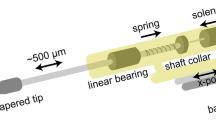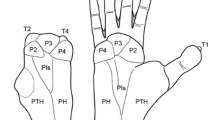Abstract
The physiological representation of the shoulder and surrounding body was examined in layer IV of somatosensory cortex (SI) in rats that had underground removal of the forelimb, either as newborns on postnatal day three (PND-3) or as adults (at least 8 weeks of age). Electrophysiological recordings were used to map the shoulder and body representations (physiological map), and the mitochondria marker, cytochrome oxidase (CO), was used to visualize recording sites in barrel and barrel-like structures (morphological map) in layer IV of deafferents and intact controls. The SI shoulder representation lies in a nebulously stained region that lies posterior to the forearm, wrist, and forepaw representations; the latter region is associated with the well-defined forepaw barrel subfield (FBS). The major findings are: (1) the shoulder is represented as a single zone located at the posterior extent of the SI body map in intact rats; (2) limb deafferentation in adult or neonatal rats that were physiologically mapped 6–16 weeks post-amputation resulted in two or more islets of ”new” representation of the shoulder in the FBS in addition to the representation of the ”original” shoulder in the posterior part of the body map; (3) deafferentations made in neonatal rats, physiologically mapped as adults, had a significantly greater (Mann-Whitney U) amount of ”new” cortical representation within the FBS than did rats deafferented as adults; (4) fewer unresponsive sites in the FBS were found for neonate deafferents than for adult deafferents; (5) evoked response latencies following electrical stimulation of the shoulder were shortest for cortical sites within the ”original” shoulder representation in intact controls, and latencies recorded at the ”original” shoulder representation in deafferents were also shorter than latencies recorded in ”new” shoulder representations in both groups of deafferents; and (6) morphological maps of the FBS were altered in neonate deafferents to the extent that the barrel structure was poorly formed, as exemplified by the absence of the four mediolateral running bands; however, the overall ovoid shape of the FBS was still apparent, but not as sharply defined as for intact controls or adult deafferents. Possible mechanisms for reorganization following large-scale deafferentation are discussed.
Similar content being viewed by others
Author information
Authors and Affiliations
Additional information
Received: 13 August 1998 / Accepted: 19 April 1999
Rights and permissions
About this article
Cite this article
Pearson, P., Li, C. & Waters, R. Effects of large-scale limb deafferentation on the morphological and physiological organization of the forepaw barrel subfield (FBS) in somatosensory cortex (SI) in adult and neonatal rats. Exp Brain Res 128, 315–331 (1999). https://doi.org/10.1007/s002210050852
Issue Date:
DOI: https://doi.org/10.1007/s002210050852




